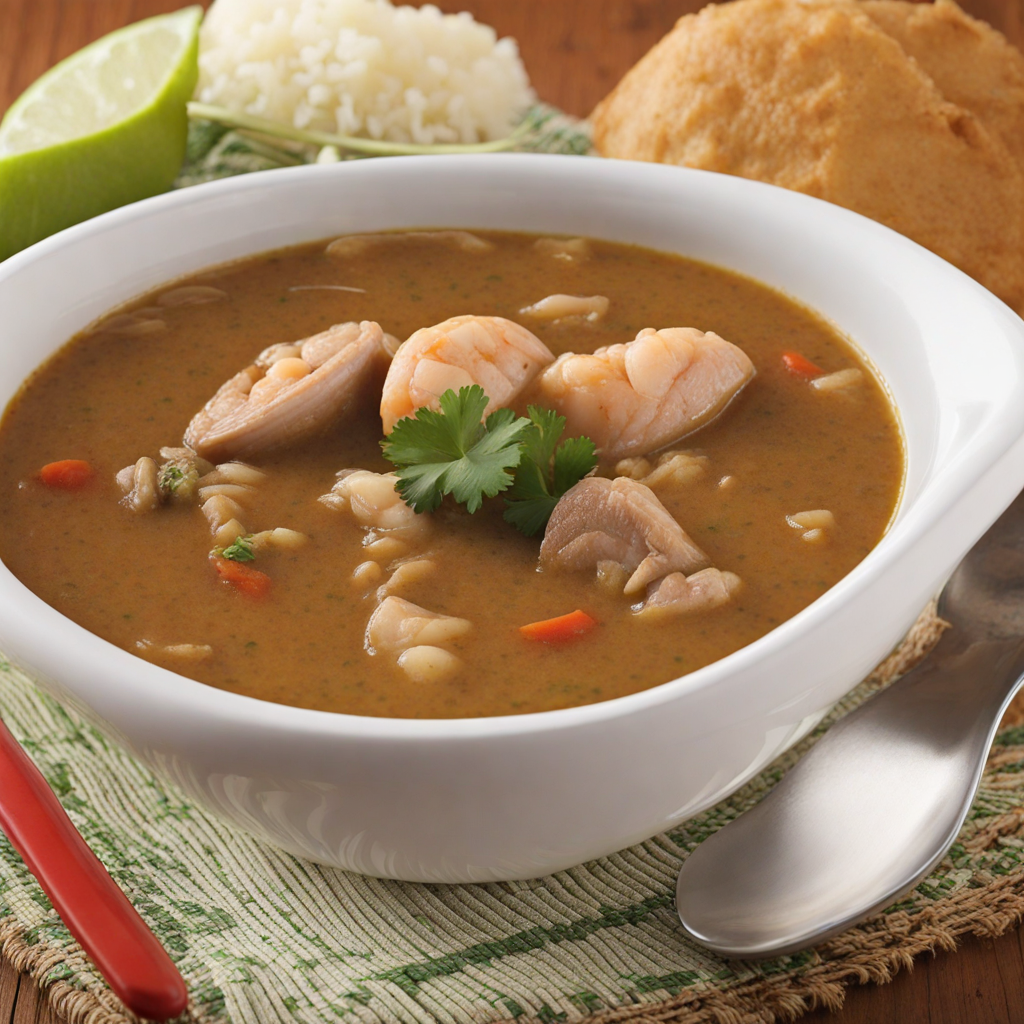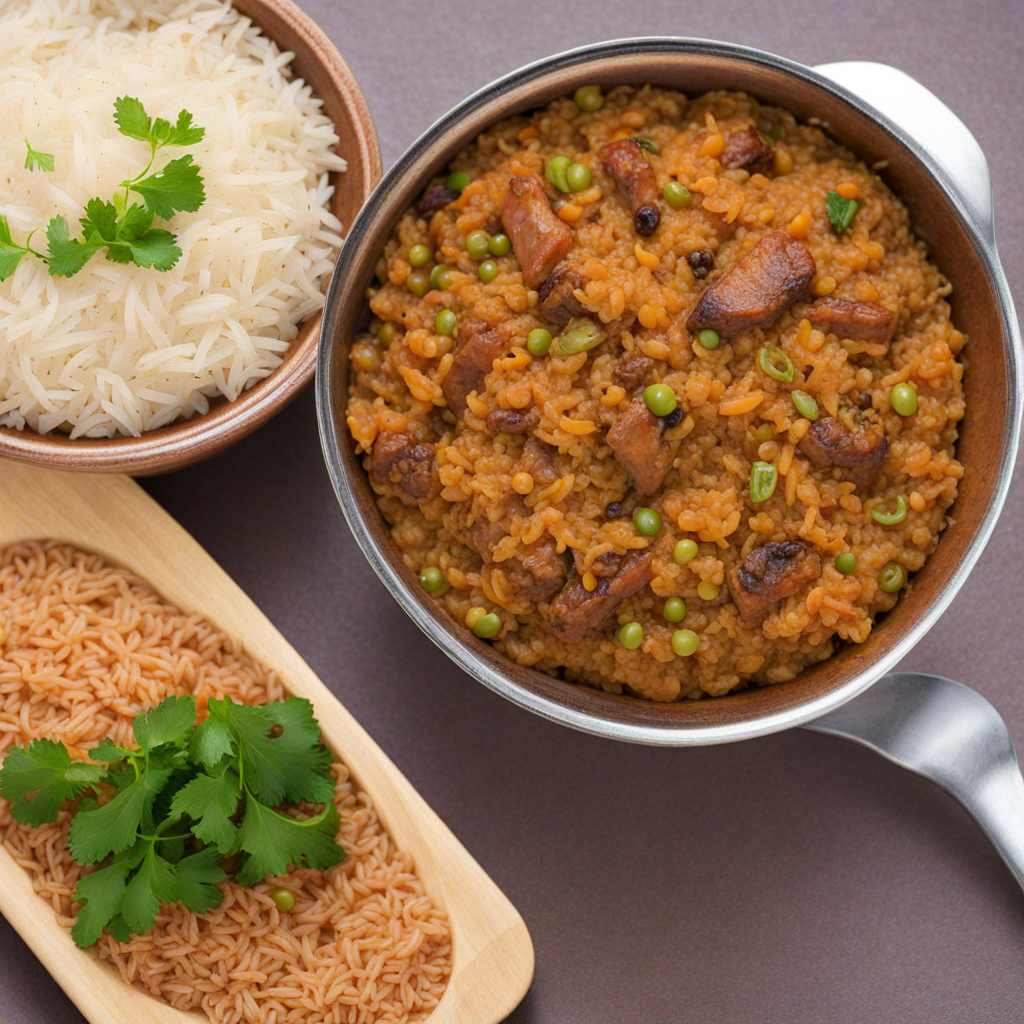Asopao
Asopao is a traditional Puerto Rican dish that beautifully encapsulates the island's rich culinary heritage. This hearty stew combines elements of both soup and rice dish, making it a comforting meal that is perfect for family gatherings or cozy nights. The origins of asopao can be traced back to the Spanish influence on Puerto Rican cuisine, particularly from the Andalusian region, where similar rice-based dishes are prevalent. Over time, it has evolved into a beloved local staple, often served during festive occasions, gatherings, and even as a remedy for the common cold. The flavor profile of asopao is vibrant and robust, characterized by a harmonious blend of spices, herbs, and umami-rich ingredients. The base is typically a savory broth, infused with sofrito, a quintessential Puerto Rican seasoning made from sautéed onions, garlic, peppers, and cilantro. This aromatic mixture forms the backbone of the dish, imparting depth and richness. Asopao is often seasoned with a variety of spices, including oregano, bay leaves, and sometimes a dash of hot sauce for a kick, reflecting the island's love for bold flavors. Whether made with chicken, seafood, or a combination of both, the dish always delivers a satisfying symphony of taste. Preparation of asopao is a labor of love that involves several key steps. First, the protein—commonly chicken, shrimp, or even crab—is seasoned and browned in a pot. Once cooked, the sofrito is added, followed by a generous
How It Became This Dish
Asopao is a traditional Puerto Rican dish that embodies the island's rich culinary heritage and cultural diversity. This hearty meal, often described as a cross between a stew and a risotto, has a fascinating history that reflects the influences of indigenous Taíno, Spanish, and African cultures. Origins The roots of asopao can be traced back to the indigenous Taíno inhabitants of Puerto Rico, who cultivated a variety of ingredients, including cassava, sweet potatoes, and a range of tropical fruits. The Taíno people's relationship with the land and their sustainable agricultural practices formed the foundation of Puerto Rican cuisine. As Spanish colonization began in the late 15th century, the culinary landscape of the island transformed dramatically. The introduction of new ingredients, such as rice, brought by the Spanish, blended seamlessly with the local produce and cooking methods. The word "asopao" itself likely derives from the Spanish term "sopa," meaning soup. Early accounts of the dish suggest that it was initially a simple broth made with local vegetables and meat. Over time, as Puerto Rico's culinary scene evolved, asopao became more complex, incorporating a variety of proteins, spices, and flavors that reflect the island's multicultural tapestry. Cultural Significance Asopao is more than just a dish; it is a symbol of Puerto Rican identity and community. Traditionally prepared for family gatherings, celebrations, and special occasions, it serves as a culinary anchor that brings people together. The preparation of asopao is often a communal activity, with family members gathering in the kitchen to chop ingredients, stir the pot, and share stories. This practice of cooking and sharing food reinforces familial ties and fosters a sense of belonging among Puerto Ricans. In addition to its role as a comfort food, asopao also reflects the island's agricultural bounty. The use of fresh, locally sourced ingredients highlights Puerto Rico's rich natural resources and the importance of sustainability in traditional cooking practices. This connection to the land is an essential aspect of Puerto Rican culture, as it not only nourishes the body but also nurtures the spirit. Development Over Time Asopao has evolved over the centuries, adapting to changing tastes and available ingredients. While the basic components of the dish remain largely the same—rice, meat (often chicken or seafood), and a flavorful broth—the variations are endless. Each family and region within Puerto Rico may have its own unique twist on asopao, incorporating different spices, vegetables, and cooking techniques. One of the most popular variations is "asopao de pollo," which features chicken simmered in a rich broth with rice, sofrito (a flavorful blend of garlic, onions, peppers, and herbs), and a medley of vegetables. Another beloved version is "asopao de mariscos," which showcases the island's abundant seafood, such as shrimp, mussels, and fish. These variations not only highlight the diversity of Puerto Rican cuisine but also illustrate how the dish can adapt to local preferences and available resources. The influence of African culinary traditions is also evident in asopao, particularly in the use of spices and cooking techniques that add depth and complexity to the dish. The incorporation of ingredients such as annatto, cilantro, and lime reflects the African diaspora's impact on Puerto Rican cuisine, creating a flavor profile that is both vibrant and comforting. As Puerto Rico experienced waves of migration and cultural exchange, asopao continued to evolve. The introduction of new ingredients, such as beans and plantains, further enriched the dish's diversity. Moreover, as globalization increased, asopao began to appear in Puerto Rican restaurants and homes outside of the island, introducing the flavors of Puerto Rico to a broader audience. In contemporary times, asopao has gained popularity not only as a traditional dish but also as a canvas for culinary creativity. Chefs and home cooks alike experiment with fusion variations, incorporating international flavors and techniques while still honoring the dish's roots. This innovation reflects a broader trend in Puerto Rican cuisine, where chefs seek to balance tradition with modernity, creating a culinary landscape that is both dynamic and rooted in heritage. Modern-Day Asopao Today, asopao is celebrated not only as a staple of Puerto Rican cuisine but also as a dish that transcends cultural boundaries. It is enjoyed during holidays, family gatherings, and casual get-togethers, often accompanied by a side of avocado or a refreshing salad. The dish's versatility makes it suitable for any occasion, whether served at a festive feast or a cozy family dinner. In Puerto Rico, asopao is often associated with the island's vibrant culinary festivals, where chefs showcase their unique interpretations of the dish. These events highlight the importance of asopao in Puerto Rican culture and serve as a platform for sharing culinary traditions with future generations. Asopao also plays a role in the ongoing conversation around food sustainability and local sourcing. With a growing interest in farm-to-table dining and a resurgence of traditional cooking methods, many Puerto Ricans are revisiting their culinary roots and emphasizing the importance of using fresh, local ingredients. This movement not only honors the heritage of asopao but also supports local farmers and promotes environmental stewardship. Conclusion In summary, asopao is more than just a comforting dish; it is a reflection of Puerto Rico's rich history, cultural significance, and culinary evolution. From its indigenous roots to its modern-day interpretations, asopao embodies the spirit of community, family, and resilience that defines Puerto Rican culture. As it continues to evolve, this beloved dish remains a symbol of identity and a celebration of the island's diverse culinary landscape. Whether enjoyed at a festive gathering or a quiet family meal, asopao is a delicious reminder of the flavors and stories that unite Puerto Ricans around the world.
You may like
Discover local flavors from Puerto Rico







